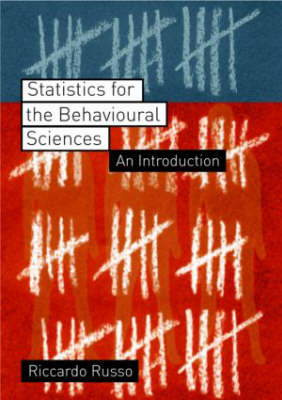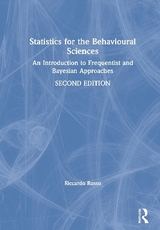
Statistics for the Behavioural Sciences
Psychology Press Ltd (Verlag)
978-1-84169-319-4 (ISBN)
- Titel erscheint in neuer Auflage
- Artikel merken
Do you find statistics overwhelming and confusing? Have you ever wished for someone to explain the basics in a clear and easy-to-follow style? This accessible textbook gives a step-by-step introduction to all the topics covered in introductory statistics courses for the behavioural sciences, with plenty of examples discussed in depth, based on real psychology experiments utilising the statistical techniques described. Advanced sections are also provided, for those who want to learn a particular topic in more depth.
Statistics for the Behavioural Sciences: An Introduction begins with an introduction to the basic concepts, before providing a detailed explanation of basic statistical tests and concepts such as descriptive statistics, probability, the binomial distribution, continuous random variables, the normal distribution, the Chi-Square distribution, the analysis of categorical data, t-tests, correlation and regression.
This timely and highly readable text will be invaluable to undergraduate students of psychology, and students of research methods courses in related disciplines, as well as anyone with an interest in the basic concepts and tests associated with statistics in the behavioural sciences.
Part I: Introduction and Basic Concepts. Why is Statistics Useful in the Behavioural Sciences? Measurement Scales. Descriptive and Inferential Statistics. What is an Experiment? Part II: Descriptive Statistics. Organising Raw Data. Frequency Distributions and Histograms. Grouped Data. Stem-and-leaf Diagrams. Summarising Data. Measures of Central Tendency: Mode, Median and Mean. Advantages and Disadvantages of Mode, Median and Mean. A Useful Digression on the Sigma Notation. Measures of Dispersion (or Variability). Further on the Mean, Variance and Standard Deviation of Frequency Distributions. How to Calculate the Combined Mean and the Combined Variance of Several Samples. Properties of Estimators. Mean and Variance of Linearly Transformed Data. Part III: Introduction to Probability. Why Are Some Notions of Probability Useful? Some Preliminary Definitions and the Concept of Probability. Venn Diagrams and Probability. The Addition Rule and the Multiplication Rule of Probability. Probability Trees. Conditional Probability. Independence and Conditional Probability. Bayes's Theorem. Part IV: Probability Distributions and the Binomial Distribution. Introduction. Probability Distributions. Calculating the Mean (µ) of a Probability Distribution. Calculating the Variance (sigma-square) and the Standard Deviation (sigma) of a Probability Distribution. Orderings (or Permutations). Combinations. The Binomial Distribution. Mean and Variance of the Binomial Distribution. How to Use the Binomial Distribution in Testing Hypotheses. The Sign Test. Further on the Binomial Distribution and Its Use in Hypothesis Testing. Part V: Continuous Random Variables and the Normal Distribution. Introduction. Continuous Random Variables and Their Distribution. The Normal Distribution. The Standard Normal Distribution. Hypothesis Testing and the Normal Distribution. Type I and Type II Errors. One-tailed and Two-tailed Statistical Tests. Using the Normal Distribution as an Approximation of the Binomial Distribution. Part VI: The Chi-square Distribution and the Analysis of Categorical Data. Introduction. The Chi-square Distribution. The Pearson's Chi-square Test. The Pearson's Chi-square Goodness of Fit Test. Further on the Goodness of Fit Test. Assumptions Underlying the Use of Pearson's Chi-square Test. Pearson's Chi-square Test and the Analysis of 2 x 2 Contingency Tables. Further on the Degrees of Freedom and the Calculation of the Expected Frequencies for any Contingency Table. The Analysis of R x C Contingency Tables. One- and Two-tailed Tests. How to Measure the Strength of the Association between Variables in a Contingency Table. A Fundamental Conceptual Equation in Data Analysis: Magnitude of a Significance Test = Size of the Effect x Size of the Study. An Important Note on the Inclusion of Non-occurrences in Contingency Tables. Part VII: Statistical Tests on Proportions. Introduction. Statistical Tests on the Proportion of Successes in a Sample. Confidence Intervals for Population Proportions. Statistical Tests on the Difference between the Proportions of Successes from Two Independent Samples. Confidence Intervals for the Differences between Two Independent Population Proportions. Statistical Tests on the Differences between Non-independent Proportions of Successes (McNemar Test). Part VIII: Sampling Distribution of the Mean and Its Use in Hypothesis Testing. Introduction. The Sampling Distribution of the Mean and the Central Limit Theorem. Testing Hypotheses about Means When Sigma is Known. Testing Hypotheses about Means When Sigma is Unknown: The Student's t-distribution and the One-Sample t-test. Two-sided Confidence Intervals for a Population Mean.
| Erscheint lt. Verlag | 19.6.2003 |
|---|---|
| Verlagsort | Hove |
| Sprache | englisch |
| Maße | 174 x 246 mm |
| Gewicht | 612 g |
| Themenwelt | Geisteswissenschaften ► Psychologie ► Test in der Psychologie |
| Mathematik / Informatik ► Mathematik ► Statistik | |
| Studium ► Querschnittsbereiche ► Epidemiologie / Med. Biometrie | |
| ISBN-10 | 1-84169-319-7 / 1841693197 |
| ISBN-13 | 978-1-84169-319-4 / 9781841693194 |
| Zustand | Neuware |
| Haben Sie eine Frage zum Produkt? |
aus dem Bereich



